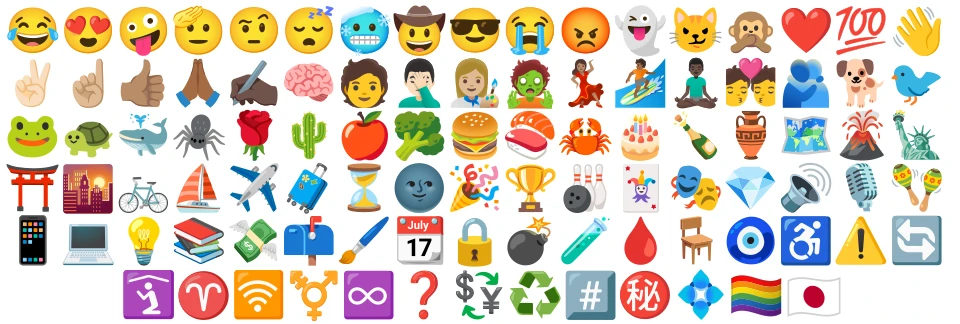Emojis have become a HUGE part of how we communicate digitally. They add tone, emotion, and personality to our messages, often replacing words entirely! Here’s a comprehensive look at emojis, covering their history, meaning, usage, and future:
1. History & Origins
- The Precursors (Emoticons): Before emojis, there were emoticons – text-based representations of facial expressions like
:)(happy) and:((sad). Scott Fahlman is credited with proposing the use of:-)and:-(on a Carnegie Mellon University bulletin board in 1982 to distinguish jokes from serious posts. - The Birth of Emoji (1999): Shigetaka Kurita, a member of the team working on i-mode, NTT DoCoMo’s mobile internet platform in Japan, is considered the creator of the first emojis. He designed 176 12×12 pixel images to facilitate communication on the limited screens of early mobile phones. They were meant to convey information quickly and efficiently, like weather forecasts or train schedules.
- Global Adoption (2010s): Emojis remained largely confined to Japan for years. Their global explosion began with their inclusion in the Unicode Standard (more on that later) and adoption by Apple (with iOS 6 in 2012) and then Google (Android). This made them accessible across different platforms and devices.
- Continued Evolution: Emojis are constantly being added and updated, reflecting cultural shifts and user demand.
2. What is an Emoji?
- Picture Characters: Emojis are small digital images or icons used to express an idea, emotion, or object.
- Unicode Standard: This is crucial. Emojis aren’t just images; they’re characters in the Unicode Standard, a universal character encoding system. This means each emoji has a unique code point, allowing it to be displayed consistently across different platforms (though the appearance can vary – see below).
- Not Just Faces: While face emojis are popular, the emoji set includes a vast range of categories:
- Smileys & People: Faces, gestures, body parts
- Animals & Nature: Animals, plants, weather
- Food & Drink: Everything from pizza to sushi
- Activity: Sports, hobbies, travel
- Objects: Tools, vehicles, everyday items
- Symbols: Hearts, stars, signs
- Flags: Representing countries and territories
3. Emoji Appearance & Variation
- Platform Differences: While the meaning of an emoji is standardized by Unicode, the visual design varies significantly between platforms (Apple, Google, Microsoft, Samsung, Twitter, Facebook, etc.). This is why a heart emoji ❤️ might look slightly different on your iPhone than on your Android phone.
- Emoji Skin Tone Modifiers: Introduced in 2015, these allow users to select different skin tones for many human emojis, promoting inclusivity. They use Fitzpatrick scale modifiers (U+1F3FB–U+1F3FF).
- Gender Variations: Many emojis now have gender options, allowing you to choose male, female, or gender-neutral versions.
- Emoji Styles: Some platforms offer different “styles” of emojis (e.g., 3D, cartoonish).
4. Emoji Usage & Meaning
- Adding Emotion & Tone: Emojis help clarify the intent behind text, preventing misinterpretations. A simple “Okay” can feel cold, but “Okay 😊️” feels much friendlier.
- Replacing Words: Emojis can stand in for entire phrases or concepts. 🍕️ = “I want pizza.” ✈️ = “I’m going on a trip.”
- Cultural Nuances: Emoji meanings can vary across cultures. What’s considered polite or funny in one culture might be offensive in another. It’s important to be mindful of this.
- Ambiguity: Sometimes, emoji meanings are open to interpretation. Context is key!
- Emoji Combinations: Users often combine emojis to create new meanings or tell stories.
- Popular Emojis: The “Face with Tears of Joy” 😂️ is consistently ranked as the most popular emoji globally. Other frequently used emojis include ❤️, 👍️, and 🙏️.
5. The Unicode Consortium & Emoji Updates
- The Gatekeepers: The Unicode Consortium is the non-profit organization responsible for maintaining the Unicode Standard, including approving new emojis.
- Emoji Proposals: Anyone can propose a new emoji to the Unicode Consortium. Proposals must meet specific criteria, including demonstrating widespread usage and distinctiveness.
- Annual Releases: New emojis are typically released annually as part of Unicode updates. The process from proposal to availability can take several years.
- Current Version: As of late 2025, Unicode 17.0 is the latest version, adding new emojis like a phoenix, pea pod, and more variations of existing ones.
6. Emoji & Language
- Emoji as a Language? While not a full-fledged language, emojis are increasingly used as a form of visual communication. Some argue they’re developing their own grammar and syntax.
- Emoji Translation: Tools and websites exist that attempt to “translate” text into emoji sequences and vice versa.
- Impact on Writing: Some studies suggest that emoji use can influence writing styles, making them more informal and expressive.
7. Resources to Explore
- Emojipedia: https://emojipedia.org/ – The definitive guide to emojis, with detailed information about their meanings, history, and appearance on different platforms.
- Unicode Consortium: https://home.unicode.org/ – The official website of the Unicode Consortium.
- Unicode Emoji Charts: https://unicode.org/emoji/charts/full-emoji-list.html – A complete list of all Unicode emojis.
In conclusion, emojis are a dynamic and evolving form of communication that has become deeply ingrained in our digital lives. They’re more than just cute pictures; they’re a powerful tool for expressing ourselves and connecting with others.
Do you have any specific questions about emojis that you’d like me to answer? For example, are you curious about:
- The meaning of a particular emoji?
- The latest emoji updates?
- How to use emojis effectively?
- The cultural implications of emojis? Let me know! 😊️
